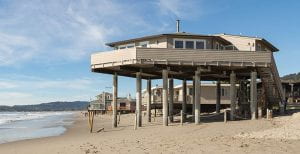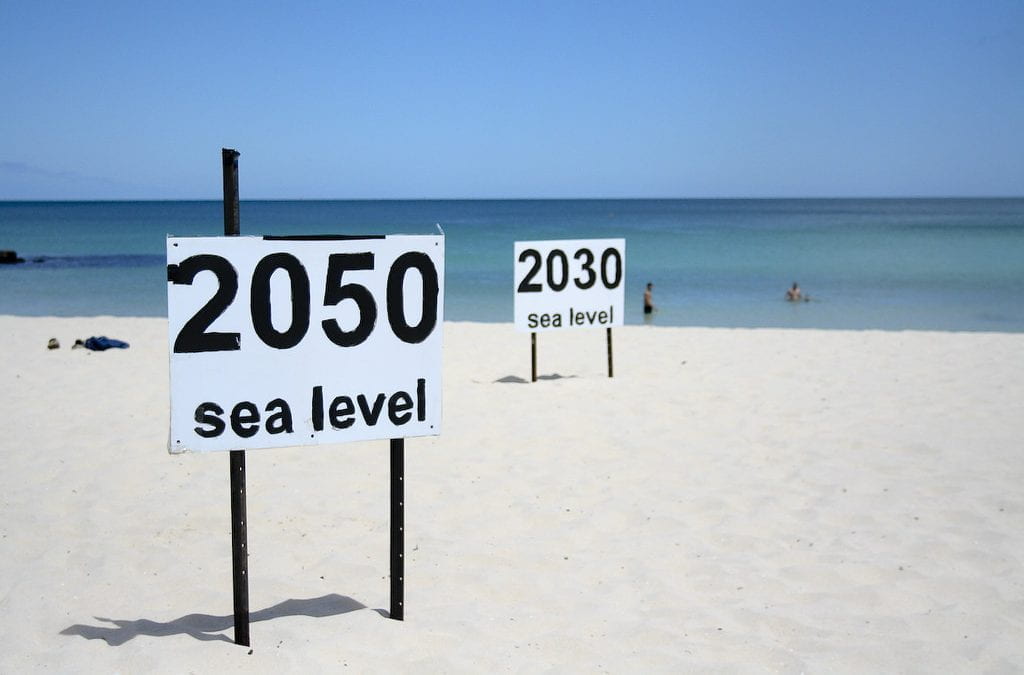The California Climate Action Team projects that climate change will cause the sea level to rise between seven and ten inches by the year 2050 and thirty-one to sixty-nine inches by 2100, affecting roughly 6% of the United States population that lives within 3 meters of sea level. Without mitigation techniques, homes, neighborhoods, and communities will face severe coastal flooding. However, use of adaptive measures may preserve these areas and enable the adoption of municipality-wide climate resilient development measures.
Utilizing adaptive measures will allow municipalities to adjust to the consequences of sea level rise passively, reactively, or anticipatorily. Planning building use long-term rather than demolishing and rebuilding structures when the sea begins to encroach reduces overall waste, retains the existing structure’s embodied carbon, and saves resources needed to build a new structure.
Municipalities should wield their land use authority to develop adaptive measures protecting new and existing developments from sea level rise. By predicting the reach of sea-level rise in their jurisdiction, municipalities can employ building placement and anchoring techniques alongside building water barriers and retrofitting buildings to preserve the longevity of their developments. Requiring new and existing developments to take these adaptive measures, enables an overall reduction of waste and consumption.

New buildings in coastal areas should anticipate sea-level rise for the building’s lifespan and be located accordingly. Laguna Beach, CA has required their new developments to adhere to regulations based on a “base flood” elevation, adjusted to reflect sea level rise over time, erroring on the side of “high-tide”. Within high coastal hazard areas, all new residential and non-residential development must be adequately elevated through anchored piling or secured columns so the lowest structural piece is at or above the base flood elevation. The developments must be further anchored to resist flotation, collapse, and lateral movement that may result from wind or water loads associated with anticipated sea level rise. New developments must meet these requirements for the expected developments’ lifetime, with a minimum of a 75-year lifespan.
Point Arena, CA has acknowledged that sea level rise may contribute to erosion, thereby endangering the future developments on bluff tops. Point Arena has used the projected effects of sea level rise on development to assess the geological stability of coastal bluffs. The city has required all new development to be located a sufficient distance, as developed by soil engineers, dependent on the possibility of gross or superficial landslides. Engineers will determine the expected 100-year erosion level plus a margin of error depending on the bluff’s landslide potential, accounting for accelerated erosion by sea level rise. Point Arena also requires that before new developments can be constructed, any potential property or life risks incurred by geologic stability, or lack thereof, must be evaluated to reduce adverse impacts.

Adaptive measures have been taken for existing buildings, building barriers or retrofitting buildings to protect structures from the rising sea. Imperial Beach, CA, through their ecotourism development design standards, have outlined adaptation measures that may be taken to adapt to sea level rise, without having to demolish and rebuild existing structures. If a building is vulnerable to the impacts of sea level rise—according to the best available science—project managers must develop an adaptation strategy of either hard structures (seawalls and levees), soft structures (wetlands, detention basins, and bioswales), accommodation (elevated grades and structures, floodable development, or floating structures), or withdrawal (buffers, rolling easements, disassembly design, or managed retreat). Project managers also have the option to create their own protective devices to protect existing principal structures and are designed to mitigate sea level rise impacts on local shoreline sand supply.
There are also building-specific adaptations that can be employed, rather than altering the natural flow of the ocean, that will preserve the building’s structural integrity in the event of sea level rise. In a guidance document, Apalachicola, FLhas developed three building-based adaptive measures to protect buildings from projected flooding in the area and that may be utilized for projected sea-level rise: elevation, wet flood proofing, and dry flood proofing. Elevation involves lifting the entire building above flood elevation, requiring additional or replacing the original foundation and bringing all livable space above the potential flooded area. Wet flood proofing allows water to flow through the building by retrofitting existing structures with water resistant materials. However, this methodology is only applicable for shallow floods because of the possibility of structural failure in high water levels. Dry flood proofing includes waterproofing the exterior of a building so that it is impermeable. Conventional wood structures can be waterproofed up to 3-feet on exterior walls but may be extended up to 4-feet with fasteners, strapping and potentially reinforce concrete. Buildings employing dry flood proofing also require closure panels on doors to keep water out of the building, and a pump to remove any water that may seep into the building.
Through the combination of building placement, barriers, and retrofitting existing buildings, structural longevity can be extended, even with the threat of sea level rise. By implementing adaptive development measures for new and existing structures, municipalities can create climate resilient development, reduce waste and natural resource consumption.

